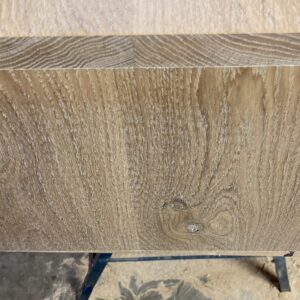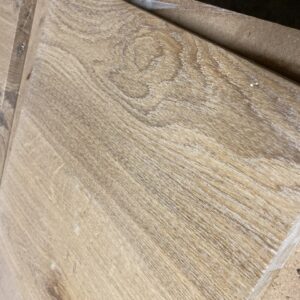I recently finished a bedside table made from European Oak. I wanted to go for a natural (light) finish and opted for Rubio’s Smoke 5%.
however, the white pigment which settled in the grain was extremely noticeable an unflattering as the photos will indicate.
any advice on application or sanding methods that may have cause this?
















Replies
It looks. like these are jointer or planer marks that have not been removed by sanding, they are either caused by uneven knives on the planer that left deep ridges or insufficient sanding with the first rough grit or both.
Thanks Gulfstar
I used a random orbital sander with 80 grit and transfered to 180 grit and cleaned with mineral spirits to remove all sanding residue.
Although I must admit, i was a bit pressed for time and didnt sand each grit long enough 😓
The 80 grit, if you chose to start with 80, should remove all the machining marks, depending on roughness I will start within 60 or 80. Then as mentioned you move to finer grits I found that the closer the grits the better and faster the job, so that will be 100, 120, 150, 180, 220 if needed, most often 150 will be enough. You don’t need to spend much time with the finer grits, I go over the surface twice, that is when I think I have covered all the surface, I do it again. In your case I would not bother stripping, I would sand with 60 grit until I get an even surface, shining a light might help, and proceed as mentioned.
If you progressed directly from 80 grit to 180 grit, that is at least part of your problem. When sanding, you should work each grit until you have removed the coarser scratches from the previous grit. This is best done incrementally progressing through the available grits. Your results would undoubtedly been better if you had done that.
Having said that, oak is a coarse wood with deep and numerous large open pores. Even with the smoothest possible sanding job, you would have been left with the color pigments filling the pores. And, you likely would have still been unsatisfied.
At this point, you will likely have to use some stripper with a brush to remove the color from the oak pores and start over. My suggestion would be to use a wood dye with a clear top coat to get the color you want.
Noted thanks, the white pigment was just to prominent for me.
I removed the old finish, sanded way more and applied rubio's - Mist, which provided a much more subtle colour compared to the raw oak.
LOL. While I'm not familiar with Rubio finishes it look like what many commercial cabinet manufacturers sell as Ceruse and is usually reserved for higher quality cabinets and at a premium usually on quatersawn white oak. It is well received and a popular finish in my area. I believe your finish did exactly what is intended to do. Removing it from the pores would be almost impossible without replaning and thinning the stock.
Thanks for response. Im just not a fan of the "white colour" settling in the grain.
I removed the finish and found Rubio's - Mist to be much more subtle.
Not totally off topic, but you should set a sanding regimen and stick to it. For example, the rule of thumb I follow is to only step up in grits by one and a half. If you start at 80, next is 120 (80 + 40), then 180 (120 + 60). If you want to go higher, next is 240 and then 320. The other general rule of thumb I try to follow is to move the sander about 1 inch per second. To get the feel for it I used to draw lines one inch apart on the wood and time myself. After a short learning curve, I got it. Now, after each grit, I write in big numbers, all over the piece, what the next grit is. Then I make sure to sand the numbers out. That helps me not miss places, sand long enough and if I have to take a break, I know which grit to pick up with.
Thanks for the tip, i'll definitely use this technique
Not a comment on the white in the oak pores but on the sanding regime. My 6" Rigid ROS has two settings, aggressive and less aggressive. I use the first (80, 150, 220) to even things up and the latter to refine the surface with 220 grit. I will then occasionally use my 1/3 sheet Makita finish sander. And even after all this work I still will find spots that need a touch up after stain is applied. This is usually done on oak or hickory. For fine grain wood like walnut I go to 320.
This forum post is now archived. Commenting has been disabled